 |
 |
|
 |
 |
Automation - or stupidisation? Move the brain from man to camera:
The 70's was a time for massive expansion for the big producers. Many of the early, smaller brands had to give up when the bigger companies filled their cameras with electronics. To reach the masses they tried to move the brain from the photographer to the camera. This was a decade when Canon came back after some twenty years in the shadow, knocking on the door. Or rather; kicking it in. But also Olympus finally started moving. And Pentax went on selling popular models, while Nikon still was the leading brand among the pros.
Canon AE-1: Central in brainmoving.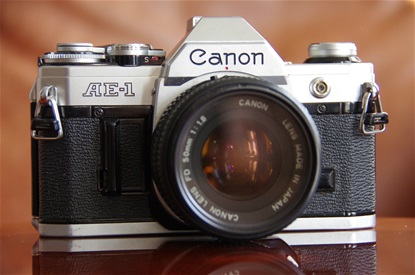
Canon AE-1: Central in brainmoving.
1971: Pentax Electro Spotmatic:
Another worlds first from Pentax: Automatic electronic shutter. Choose aperture value and the camera picks the correct shutter time according to the EV reading from the light meter. Released first in Japan in '71, then an improved version worldwide under the name ES and later ES II. Sn. 5537890.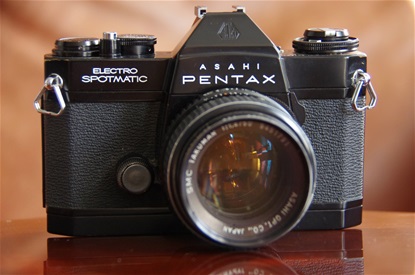
Another worlds first from Pentax: Automatic electronic shutter. Choose aperture value and the camera picks the correct shutter time according to the EV reading from the light meter. Released first in Japan in '71, then an improved version worldwide under the name ES and later ES II. Sn. 5537890.
1971 was also the year of the introduction of the first multi layer glass, giving better colours and contrast. Again Pentax was first with the Takumar SMC lenses. Here the legendary 50/1,4. Sn. 5451791.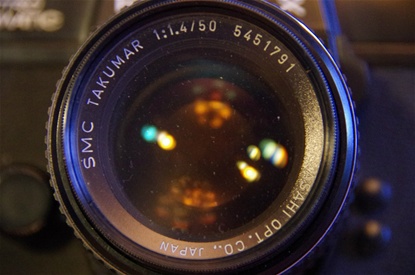
1971 was also the year of the introduction of the first multi layer glass, giving better colours and contrast. Again Pentax was first with the Takumar SMC lenses. Here the legendary 50/1,4. Sn. 5451791.
The shutter time dial goes from 1/1000 to 1/60 + B. You can shoot in manual mode choosing from these shutter times, or choose "Automatic", which makes the camera decide the correct speed from 1 sec to 1/1000. Round the unfoldable rewind crank, there is ASA setting and over/under exposure control. The small button is for battery check.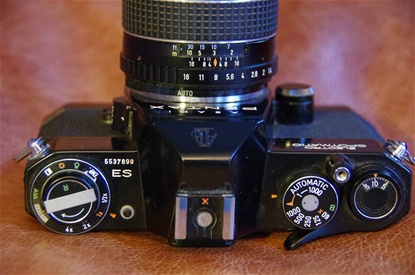
The shutter time dial goes from 1/1000 to 1/60 + B. You can shoot in manual mode choosing from these shutter times, or choose "Automatic", which makes the camera decide the correct speed from 1 sec to 1/1000. Round the unfoldable rewind crank, there is ASA setting and over/under exposure control. The small button is for battery check.
Fujica ST 701 was the first PP SLR camera to introduce a silicon cell for light metering. The silicon cell reacted faster to shifting light than the previous CdS cell. Sn. 8081680.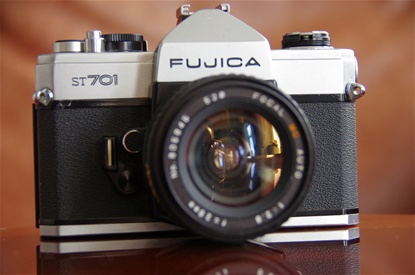
Fujica ST 701 was the first PP SLR camera to introduce a silicon cell for light metering. The silicon cell reacted faster to shifting light than the previous CdS cell. Sn. 8081680.
All controls where you would like to have them.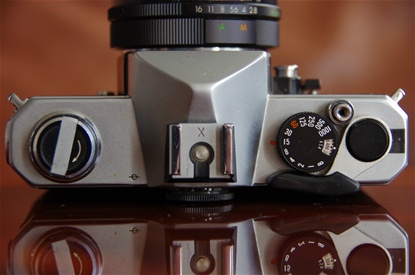
All controls where you would like to have them.
Olympus had been on the sideline in terms of PP SLR development. It took them some 17 years from the introduction of Orion/Miranda T, as the first japanese PP SLR, before they came up with an answer. The model they introduced was the M-1, later called OM-1 after protests from Leica. What made it famous was the dramatic small size, only 136x83x50mm and the weight of 510 grams. Olympus at the same time introduced a series of highly professional lenses. Three years later they launched the OM-2, the first camera to offer a TTL flash system.
Sn: 260413.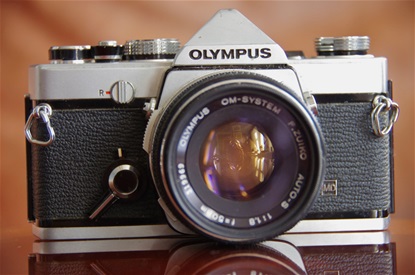
Olympus had been on the sideline in terms of PP SLR development. It took them some 17 years from the introduction of Orion/Miranda T, as the first japanese PP SLR, before they came up with an answer. The model they introduced was the M-1, later called OM-1 after protests from Leica. What made it famous was the dramatic small size, only 136x83x50mm and the weight of 510 grams. Olympus at the same time introduced a series of highly professional lenses. Three years later they launched the OM-2, the first camera to offer a TTL flash system.
Sn: 260413.
Note the shutter speed ring inside the lens and ASA setting where others had the shutter speed dial.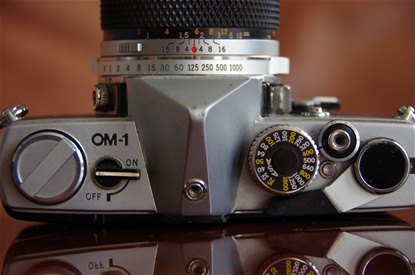
Note the shutter speed ring inside the lens and ASA setting where others had the shutter speed dial.
Another brain mover: Pentax ME, following Olympus in making a very compact PP SLR camera, was the first to come with a totally automatic shutter. Size: 131x82,5x49,5mm. Weight: 460grams. That was even smaller and lighter than the OM.
And: With the M series, Pentax introduced a new photocell, the GPD cell, Gallium Photo Diode, consisting of gallium, arsen and phosphor. Thus Pentax took another step forward, not only following Fujica, as most others did.
Sn. 1716473.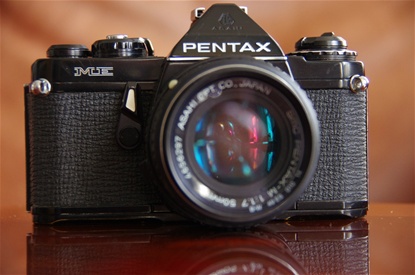
Another brain mover: Pentax ME, following Olympus in making a very compact PP SLR camera, was the first to come with a totally automatic shutter. Size: 131x82,5x49,5mm. Weight: 460grams. That was even smaller and lighter than the OM.
And: With the M series, Pentax introduced a new photocell, the GPD cell, Gallium Photo Diode, consisting of gallium, arsen and phosphor. Thus Pentax took another step forward, not only following Fujica, as most others did.
Sn. 1716473.
No shutter time dial, only L(ocked), Auto, flash speed 1/100 and B.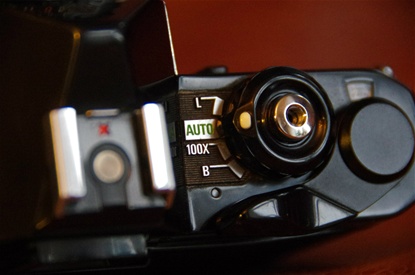
No shutter time dial, only L(ocked), Auto, flash speed 1/100 and B.
At last; Canon had a worlds first, A camera with built in microprocessor electronics. After having been left in the shadow by Nikon F system among the pros, and Asahi Pentax Spotmatic system in the mass market, they now aimed at taking back a central position. The total sales of cameras took another leap with the AE-1, selling some 5 million alone. This camera has sn. 5001739.
The camera was followed up by the A-1 and later the AE-1 Program, both underlining the comeback and later domination by Canon.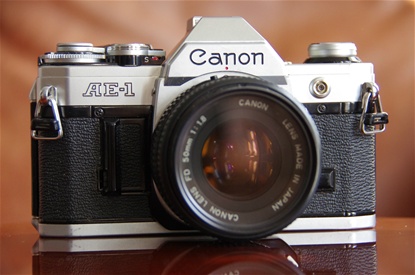
At last; Canon had a worlds first, A camera with built in microprocessor electronics. After having been left in the shadow by Nikon F system among the pros, and Asahi Pentax Spotmatic system in the mass market, they now aimed at taking back a central position. The total sales of cameras took another leap with the AE-1, selling some 5 million alone. This camera has sn. 5001739.
The camera was followed up by the A-1 and later the AE-1 Program, both underlining the comeback and later domination by Canon.
Shutter time dial under the winder. The big diameter made it possible to set speed only by using finger tip. (Inherited from Zunow of '58.) The winder had an ultra short movement. On/off switch to the left of shutter release button.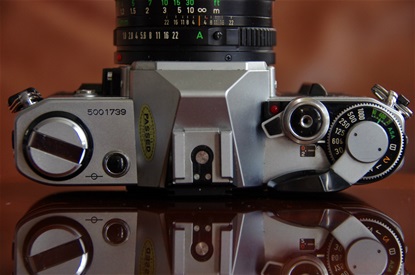
Shutter time dial under the winder. The big diameter made it possible to set speed only by using finger tip. (Inherited from Zunow of '58.) The winder had an ultra short movement. On/off switch to the left of shutter release button.
As Pentax and Canon had started the race, others had to follow or leave. While most others tried to copy the Canon (and Pentax) success, Minolta went further, as they introduced worlds first double program slr camera in '77. The XD7 (XD or XD11 in some markets) let you chose between electronic shutter or aperture control.
Minoltas XD7 was worlds number one to offer the choice between Aperture controlled or Shutter controlled automathics. 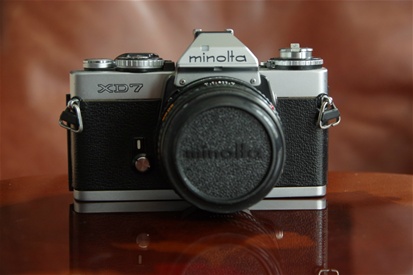
Minoltas XD7 was worlds number one to offer the choice between Aperture controlled or Shutter controlled automathics.
A winder with very short travel to the right.Shutter release button placed in the center of the shutter time dial, where O was the choice in A(perture) mode. Then there was the S(hutter) mode and a M(anual) mode.
On the left hand side one will find ASA values. Press the button to open the dial. Then the over/under exposure handle to choose from +2 to -2 steps. And of course the foldable rewind crank. Sn. on the flash shoe: 2142500. Sn. of the lens (Rokkor 50/1,8 RD): 5367106.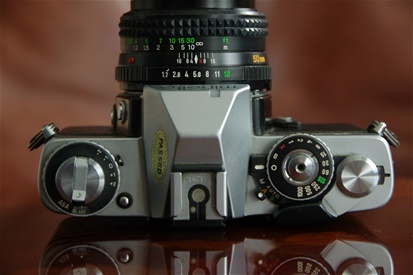
A winder with very short travel to the right.Shutter release button placed in the center of the shutter time dial, where O was the choice in A(perture) mode. Then there was the S(hutter) mode and a M(anual) mode.
On the left hand side one will find ASA values. Press the button to open the dial. Then the over/under exposure handle to choose from +2 to -2 steps. And of course the foldable rewind crank. Sn. on the flash shoe: 2142500. Sn. of the lens (Rokkor 50/1,8 RD): 5367106.
First fully programmed PP SLR.
Beginning of Canons takeover.
Beginning of the end of Man's brain?
Through the A-1 model, Canon led the way into the world of fully automized program cameras. Sn. 660646.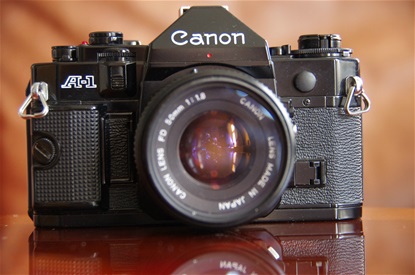
Through the A-1 model, Canon led the way into the world of fully automized program cameras. Sn. 660646.
Multi program: Fully automatic (camera takes full control), Tv (you control shutter, camera controls aperture), Av (you control aperture, camera controls shutter), fully manual (you control everything). 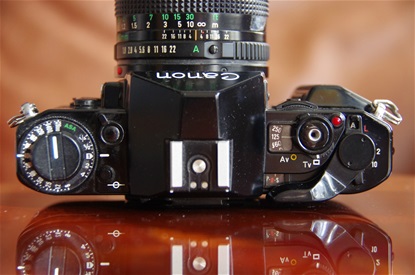
Multi program: Fully automatic (camera takes full control), Tv (you control shutter, camera controls aperture), Av (you control aperture, camera controls shutter), fully manual (you control everything).
For the first time: "A" on the lens (automatic aperture control) and "P" on the shutter dial (automatic shutter time control).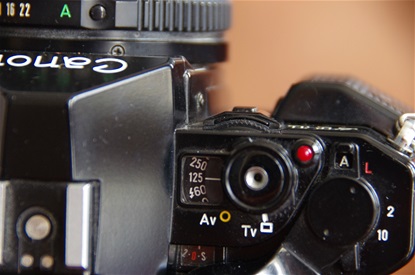
For the first time: "A" on the lens (automatic aperture control) and "P" on the shutter dial (automatic shutter time control).
|
|
 |
|
|
|